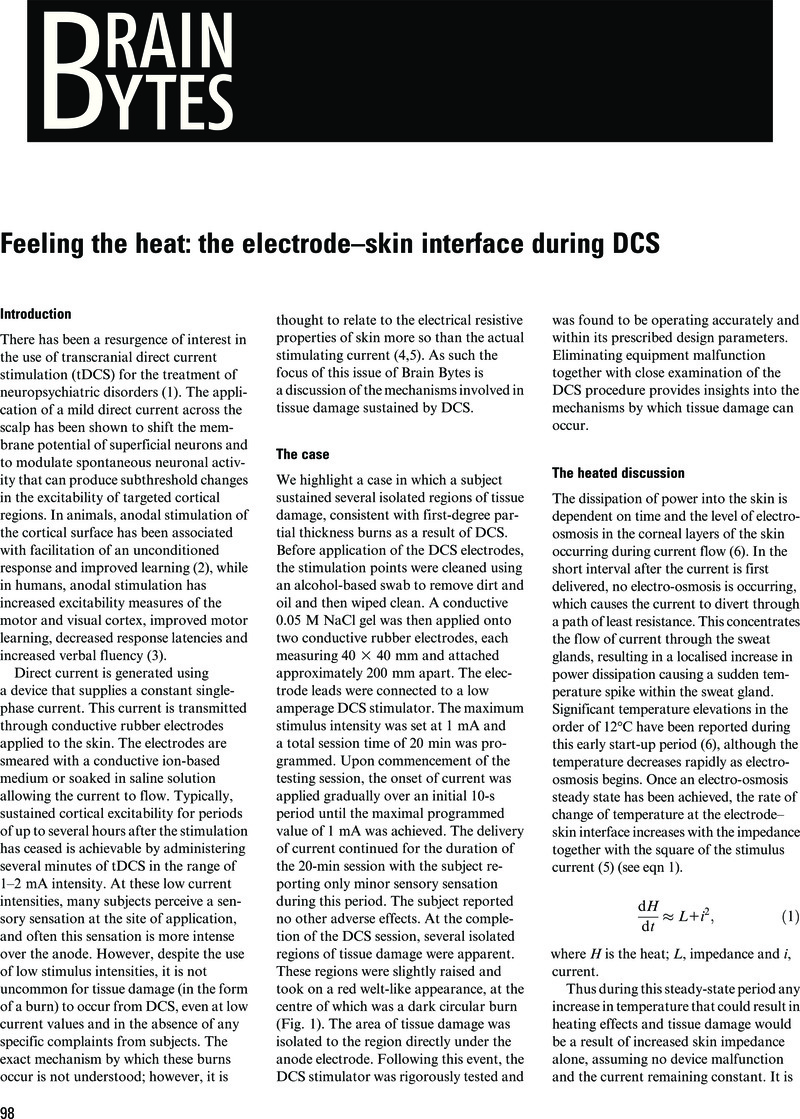Crossref Citations
This article has been cited by the following publications. This list is generated based on data provided by Crossref.
Wilkinson, David
Zubko, Olga
and
Sakel, Mohamed
2009.
Safety of repeated sessions of galvanic vestibular stimulation following stroke: A single-case study.
Brain Injury,
Vol. 23,
Issue. 10,
p.
841.
Datta, A.
Elwassif, M.
and
Bikson, M.
2009.
Bio-heat transfer model of transcranial DC stimulation: Comparison of conventional pad versus ring electrode.
p.
670.
Bikson, Marom
Datta, Abhishek
and
Elwassif, Maged
2009.
Establishing safety limits for transcranial direct current stimulation.
Clinical Neurophysiology,
Vol. 120,
Issue. 6,
p.
1033.
Minhas, Preet
Bansal, Varun
Patel, Jinal
Ho, Johnson S.
Diaz, Julian
Datta, Abhishek
and
Bikson, Marom
2010.
Electrodes for high-definition transcutaneous DC stimulation for applications in drug delivery and electrotherapy, including tDCS.
Journal of Neuroscience Methods,
Vol. 190,
Issue. 2,
p.
188.
Utz, Kathrin S.
Korluss, Kathia
Schmidt, Lena
Rosenthal, Alisha
Oppenländer, Karin
Keller, Ingo
and
Kerkhoff, Georg
2011.
Minor adverse effects of galvanic vestibular stimulation in persons with stroke and healthy individuals.
Brain Injury,
Vol. 25,
Issue. 11,
p.
1058.
Loo, C. K.
Martin, D. M
Alonzo, A.
Gandevia, S.
Mitchell, P. B.
and
Sachdev, P.
2011.
Avoiding skin burns with transcranial direct current stimulation: preliminary considerations.
The International Journal of Neuropsychopharmacology,
Vol. 14,
Issue. 03,
p.
425.
Minhas, Preet
Datta, Abhishek
and
Bikson, Marom
2011.
Cutaneous perception during tDCS: Role of electrode shape and sponge salinity.
Clinical Neurophysiology,
Vol. 122,
Issue. 4,
p.
637.
Holland, Rachel
and
Crinion, Jenny
2012.
Can tDCS enhance treatment of aphasia after stroke?.
Aphasiology,
Vol. 26,
Issue. 9,
p.
1169.
Palm, Ulrich
Feichtner, Katrina B.
Hasan, Alkomiet
Gauglitz, Gerd
Langguth, Berthold
Nitsche, Michael A.
Keeser, Daniel
and
Padberg, Frank
2014.
The Role of Contact Media at the Skin-electrode Interface During Transcranial Direct Current Stimulation (tDCS).
Brain Stimulation,
Vol. 7,
Issue. 5,
p.
762.
Thair, Hayley
Holloway, Amy L.
Newport, Roger
and
Smith, Alastair D.
2017.
Transcranial Direct Current Stimulation (tDCS): A Beginner's Guide for Design and Implementation.
Frontiers in Neuroscience,
Vol. 11,
Issue. ,
Matsumoto, Hideyuki
and
Ugawa, Yoshikazu
2017.
Adverse events of tDCS and tACS: A review.
Clinical Neurophysiology Practice,
Vol. 2,
Issue. ,
p.
19.
Khadka, Niranjan
Zannou, Adantchede L.
Zunara, Fatima
Truong, Dennis Q.
Dmochowski, Jacek
and
Bikson, Marom
2018.
Minimal Heating at the Skin Surface During Transcranial Direct Current Stimulation.
Neuromodulation: Technology at the Neural Interface,
Vol. 21,
Issue. 4,
p.
334.
Kvasnak, Eugen
and
Haugen, Kine Haldorsen
2018.
Sensation and pain thresholds of transcranial stimulation with direct and alternating electric current.
p.
1.
Chen, Luyao
Ke, Ang
Zhang, Peng
Gao, Zhaolong
Zou, Xuecheng
and
He, Jiping
2018.
Bioheat transfer model of transcutaneous spinal cord stimulation-induced temperature changes.
PeerJ,
Vol. 6,
Issue. ,
p.
e4921.
Kvašňák, E.
2019.
Perception and pain thresholds of tDCS and tACS.
Physiological Research,
p.
S427.
Kortteenniemi, Aaron
Lehto, Soili M.
and
Javadi, Amir-Homayoun
2019.
Delayed, distant skin lesions after transcranial direct current stimulation.
Brain Stimulation,
Vol. 12,
Issue. 1,
p.
204.
Khadka, Niranjan
Woods, Adam J.
and
Bikson, Marom
2019.
Practical Guide to Transcranial Direct Current Stimulation.
p.
263.
Solomons, Cassandra D
and
Shanmugasundaram, Vivekanandan
2020.
Transcranial direct current stimulation: A review of electrode characteristics and materials.
Medical Engineering & Physics,
Vol. 85,
Issue. ,
p.
63.
Fiocchi, Serena
Bonato, Marta
Chiaramello, Emma
Gallucci, Silvia
Tognola, Gabriella
Ravazzani, Paolo
and
Parazzini, Marta
2020.
Numerical modelling of temperature increase induced by transcutaneous Spinal Direct Current Stimulation (tsDC).
p.
424.
Pilloni, Giuseppina
Woods, Adam J.
and
Charvet, Leigh
2021.
No risk of skin lesion or burn with transcranial direct current stimulation (tDCS) using standardized protocols.
Brain Stimulation,
Vol. 14,
Issue. 3,
p.
511.



